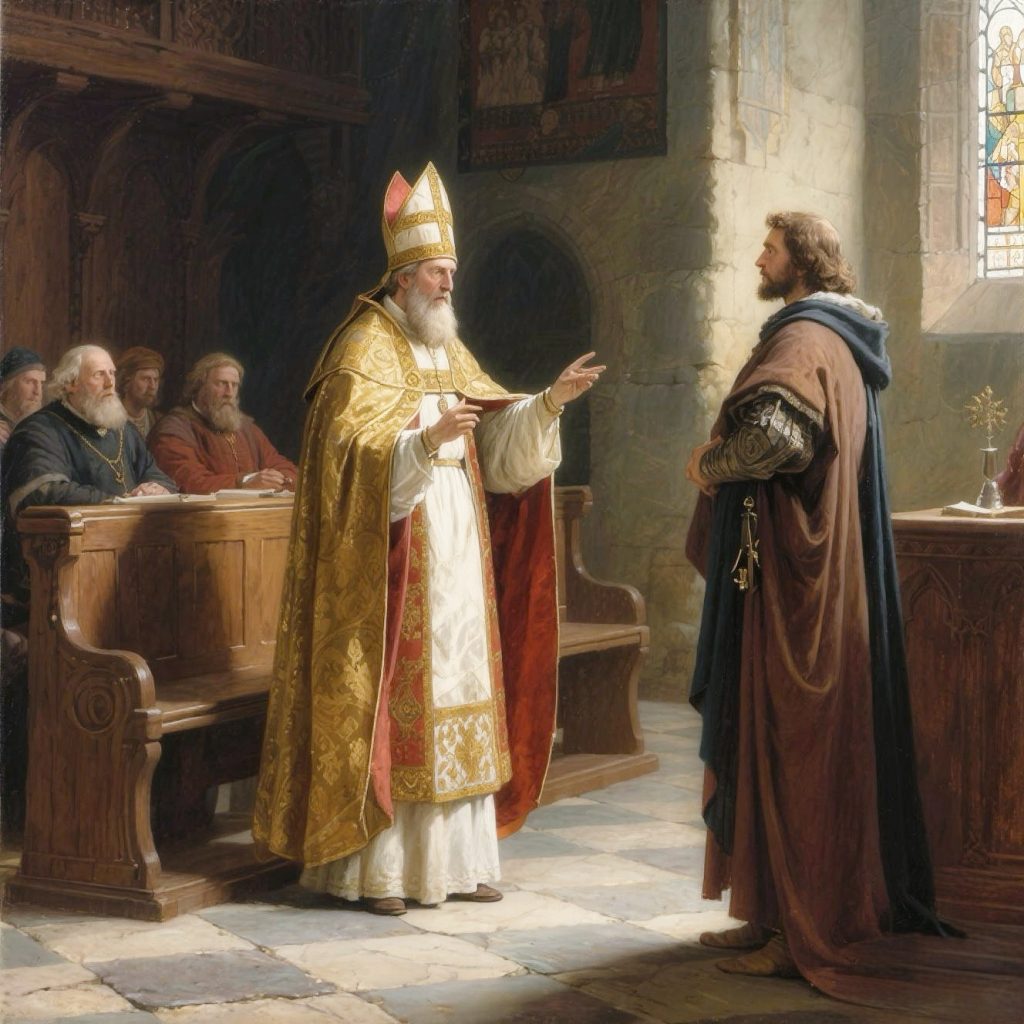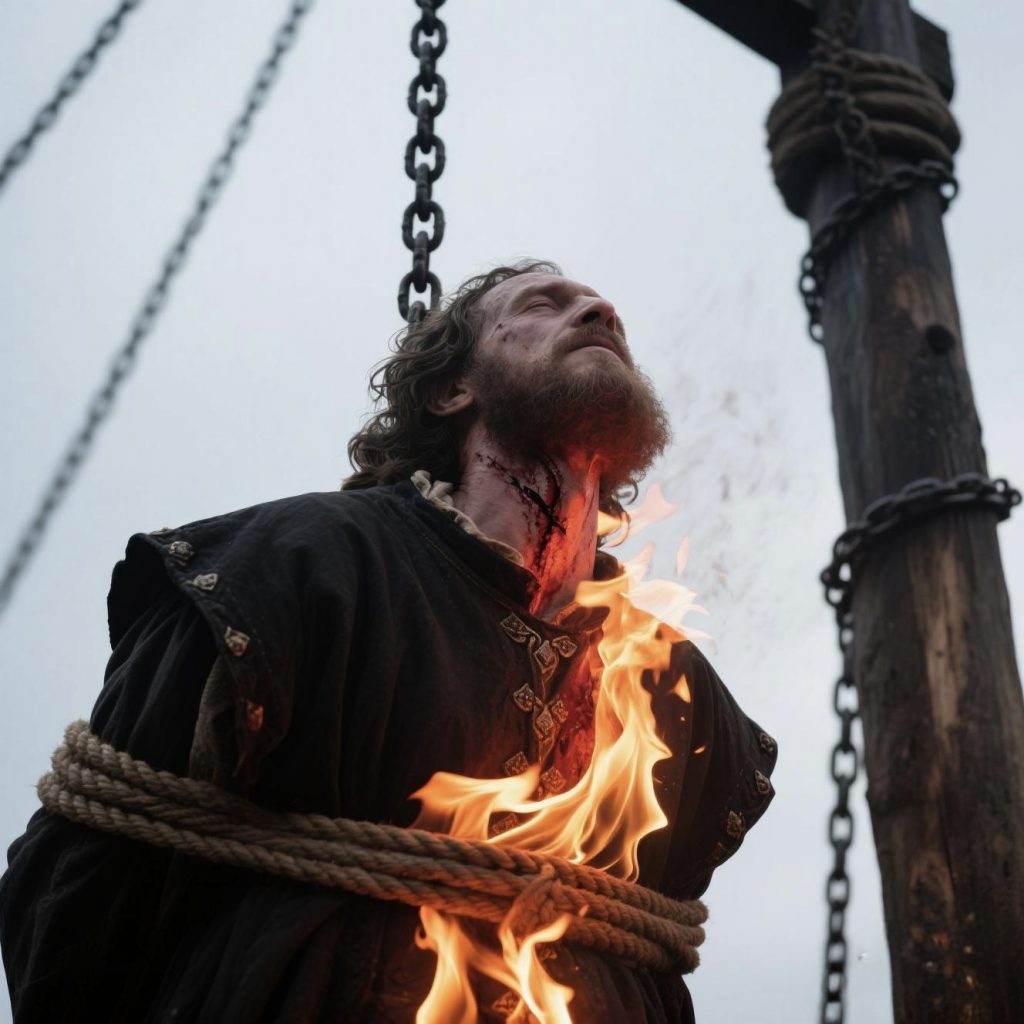In the winter of 1417 the crowds at St Giles’ Fields saw an unusual punishment: Sir John Oldcastle, once a royal companion and soldier of renown, was first hanged in chains and then burned to ashes. Why both? Was he rebel, heretic, martyr, or fool? The authorities insisted he was all of these at once, and made sure his death carried that message. His story – from Marcher knight to the leader of a failed rising – remains one of the strangest collisions of faith, politics, and personal conviction in medieval England.
Sir John Oldcastle, Lord Cobham, had made his reputation in the Welsh wars, married into the Cobham family of Kent, and enjoyed the personal friendship of Henry, Prince of Wales. When that prince became Henry V in March 1413, Oldcastle might have expected royal protection. Instead he found himself condemned for holding doctrines that struck at the heart of medieval religion.
John Oldcastle: Soldier, Marcher Lord, and Cobham by Marriage
John Oldcastle was born in Herefordshire around 1370, the son of Richard Oldcastle of Almeley and his wife Isabel. The Oldcastles were a well-established gentry family of the Welsh border, where military service was both expected and rewarded. John came of age during the turbulent reign of Richard II, and first made his name under Henry IV in the wars against Owain Glyndŵr. As a marcher knight he was active in campaigns through the first decade of the fifteenth century, fighting at both Monmouth and Glamorgan.
In about 1408 he married Joan, the heiress of Sir John Cobham of Kent. The match transformed his status. Through her he acquired not only the title of Lord Cobham but substantial estates centred on Cooling Castle. By 1409 he was summoned to Parliament as a baron in his own right. He moved easily in court circles and joined Henry, Prince of Wales, in his French expedition of 1411. Oldcastle was now a man of stature: a landholder in two important regions, with a career of service to the Lancastrian dynasty. His friendship with the young prince seemed to secure his place among the king’s trusted supporters.
Sir John Oldcastle Accused of Heresy
That career was abruptly derailed by his commitment to Lollard teaching. Oldcastle had long been sympathetic to Wycliffite ideas, especially among the London circles where such views circulated. Within months of Henry V’s accession, Archbishop Thomas Arundel opened proceedings against him.
At St Paul’s in September 1413 Oldcastle was required to answer for specific articles of heresy preserved in Arundel’s register (see Appendix). They can be summarised as follows:
- Eucharist: bread and wine remain after consecration and are only sacramentally Christ’s body and blood. They don’t actually become the body and blood of Christ, and are only symbols.
- Confession: confession to a priest is unnecessary; sins should be confessed to God alone.
- Papal Authority: the pope is not head of the universal church, nor was Peter given greater authority than other apostles.
- Images and Pilgrimages: pilgrimages and image-worship are not to be approved, since they misdirect the honour due to God.
- Clergy and Wealth: priests should hold no temporal possessions, living instead on tithes and offerings in poverty.

Oldcastle openly admitted that he had “long held” such views. Henry V, hoping for reconciliation, intervened to give his old companion time to reflect. But Oldcastle refused to recant. That defiance made him legally a heretic obstinate. He was condemned and sent to the Tower to await execution.
Lynn Citizens Accused of Lollardy
At least three citizens of Lynn (then Bishop’s Lynn, now King’s Lynn) had come under suspicion for holding similar views to Oldcastle. William Sawtry was the first priest to be burned alive for heresy under Henry IV’s new law (De heretico comburendo) in 1401. A certain Nicholas Drye of Lynn was tried in 1430 in Norwich for being suspected of Lollardy. Nicholas admitted these accusations were true. Nicholas was made to swear on the Gospels that from now on he would never again believe or spread these false teachings or any other ideas that went against the Catholic faith or the Roman Church. He appears to have avoided the fire.
Lynn’s Margery Kempe was very orthodox in her faith and far from being a Lollard. Nevertheless she wasn’t always popular with people and was accused of being a Lollard on several occasions. Even before the Oldcastle Lollard Rising in 1414 Margery had aroused suspicion and was being threatened with burning at both Canterbury and London. After the 1414 Rising people were even more suspicious of her, and when Margery was arrested in Leicester it was the mayor rather than the abbot driving the prosecution. In the North, when Margery was under arrest and being taken to Beverley, a mob of women came out crying for her to be burned.
Oldcastle’s Escape and the Rising of January 1414
Before sentence could be carried out, Oldcastle escaped from the Tower. By the New Year he was again active, this time as the leader of a bold but poorly organised plot. Notices circulated calling men to gather at St Giles’ Fields outside London on 9 January 1414. The plan, according to hostile chroniclers, was to seize the king during Twelfth Night revels and impose sweeping religious change.
Whether that was truly the aim is doubtful, but the muster was real enough. Henry was forewarned and moved swiftly. With troops drawn into the city he blocked the approaches to St Giles. Those who assembled were overwhelmed or captured; some were executed at once, accused of both heresy and treason. Oldcastle evaded capture again, disappearing into hiding.
Fire and Faggot
The rising had lasting consequences. In May 1414 Henry convened Parliament at Leicester, later nicknamed the “Fire and Faggot” Parliament for its harsh measures. Justices of the peace were empowered to track down suspected heretics and to assist bishops in suppressing them. From this moment, heresy was not only an ecclesiastical matter but a political crime. Oldcastle’s rising had hardened the crown’s resolve: religious dissent and disobedience to the king were now indistinguishable.
Heresy had become treason.
Oldcastle’s Four Years on the Run
Oldcastle remained at large for nearly four years, sheltered by sympathisers in the Marches and beyond. He was implicated by rumour in subsequent disturbances, particularly in 1415, but no fresh rising of note came. He was hunted relentlessly by royal officers, who issued repeated proclamations for his capture. His noble status and regional connections kept him alive, but he could not re-establish his cause.
Sir John Oldcastle’s Capture and Execution
In late 1417 his luck ran out. He was captured in Shropshire by Lord Charlton of Powis and taken to London. Oldcastle appeared before Parliament in December, reportedly preaching a defiant sermon before the assembly, asserting his continued loyalty to the deposed Richard II and denouncing the current regime. There was no new trial: his condemnation of 1413 was revived.

On 14 December 1417, at St Giles’ Fields – the very ground where his rising had failed – Oldcastle was executed. The manner of execution was grim and exemplary: he was hanged over a fire, and the gallows itself was burnt while he was still hanging, combining the punishments of both heresy (burning) and felony (hanging). Oldcastle’s two identities were fused into one brutal spectacle.
This combination of hanging and burning at the stake was intended to both punish and warn others, reflecting the seriousness with which the authorities regarded both his religious defiance and repeated rebellion.
Sir John Oldcastle’s Legacy
Oldcastle’s afterlife has been tangled. To contemporaries he was both a dangerous rebel and a cautionary tale about mixing doctrine with sedition. To later Protestants he became a martyr: John Foxe’s Acts and Monuments included a vivid woodcut of his burning, portraying him as serene in the flames. And in the theatre he re-emerged, half-forgotten: Shakespeare’s first drafts of Henry IV gave his fat knight the name Oldcastle, later altered to Falstaff under pressure from Cobham descendants.
The historical Oldcastle was neither Falstaffian buffoon nor wholly Protestant martyr. He was a soldier of the Welsh Marches, ennobled by marriage, trusted by a king, and finally destroyed by his own refusal to recant. His rebellion was crushed in a single night, but its consequences reshaped the law: after 1414 heresy and treason were bound together, and dissent had to retreat underground. For that shift, and for the drama of his defiance, Oldcastle’s name still resonates six centuries later.
Appendix: The Articles Against Sir John Oldcastle Oldcastle
Here is a side-by-side presentation of the main articles against Oldcastle, based on the record in Arundel’s register (Lambeth Palace Library, Reg. Arundel, ff. 399–402). The Latin text is given in a representative form (from Wilkins, Concilia, III, 355–6, and Thomson, The Later Lollards, pp. 41–42), with a plain English rendering alongside.
| Latin (abridged from Arundel’s register) | English translation |
| 1. Quod in sacramento altaris post consecrationem panis materialis remanet, nec transsubstantiatur in verum corpus Christi, licet sit sacramentaliter corpus Christi. | 1. On the Sacrament of the Altar: That in the sacrament of the altar, after consecration, the material bread remains, and is not transubstantiated into the very body of Christ, although it is sacramentally the body of Christ. |
| 2. Quod confessio auricularis sacerdoti facta non est necessaria ad salutem, sed sufficit hominem confiteri peccata sua soli Deo. | 2. On Confession: That auricular confession made to a priest is not necessary for salvation; it is sufficient for a man to confess his sins to God alone. |
| 3. Quod Romanus pontifex non est caput ecclesiae universalis, nec sancto Petro maiora privilegia data fuerunt a Christo quam cuilibet alteri apostolo. | 3. On the Pope: That the Roman Pontiff is not the head of the universal Church, nor were greater privileges given by Christ to St Peter than to any other apostle. |
| 4. Quod peregrinationes ad loca sancta, et adoratio imaginum, non sunt approbandae; quia per hoc praecepta Dei infringuntur, et honor qui soli debetur Deo transfertur ad creaturas. | 4. On Pilgrimages and Images: That pilgrimages to holy places, and the adoration of images, are not to be approved; for by this the commandments of God are broken, and the honour that is due to God alone is transferred to creatures. |
| 5. Quod non licet sacerdotibus Christi ecclesiae possessiones, redditus, aut dominium temporale habere; sed debent vivere tantummodo de decimis et oblationibus populi, in paupertate et simplicitate, sicut Christus ordinavit. | 5. On the Clergy and Temporal Possessions: That it is not lawful for priests of Christ’s Church to hold possessions, rents, or temporal dominion; but they ought to live only by tithes and offerings of the people, in poverty and simplicity, as Christ ordained. |
© James Rye 2025
See also: William Sawtry: Lynn Priest makes national headlines
Book a Walk with a Trained and Qualified King’s Lynn Guide
Further Reading
- Arundel, Thomas. Register of Thomas Arundel, Archbishop of Canterbury, 1397–1414, ed. F. Donald Logan. 2 vols. Canterbury and York Society, 1965.
- Foxe, John. Acts and Monuments (1563 and later editions).
- Hudson, Anne. The Premature Reformation: Wycliffite Texts and Lollard History. Oxford: Clarendon Press, 1988.
- Hudson, Anne. “Oldcastle, John, Baron Cobham (d. 1417).” Oxford Dictionary of National Biography. Oxford: OUP, 2004.
- McFarlane, K. B. Lancastrian Kings and Lollard Knights. Oxford: Clarendon Press, 1972.
- Powicke, F. M. King Henry V. Oxford: Clarendon Press, 1949.
- Strohm, Paul. Heresy, Literature, and Politics in Late Medieval England. Ithaca: Cornell University Press, 1993.
- Summerson, Henry. Sir John Oldcastle: The Making of a Martyr. London: History Today, 1985 (Article).
- Vernon, Matthew. “The Trial of Sir John Oldcastle.” In Heresy and Politics in the Reign of Henry V, edited by Peter McNiven. Manchester: Manchester University Press, 1987.
